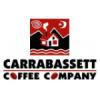Off Campus & On the Trails
Colby College promotes interdisciplinary exploration by making sure students have the opportunity to explore their interests outside of the classroom. As a partner with Colby, Maine Huts & Trails helps to provide an opportunity to discover the skills and connections that are beneficial to the student's path.
This past January, Geology & Environmental Science student Eli, spent time in all 4 Huts focusing on outdoor education and operation of the off the grid systems.
Eli's insights from the Colby Blog were not only valuable to his studies but give a fresh perspective for anyone visiting the MH&T system. Thank you Eli!
Blog articles reposted with permission from www.colby.edu
Poplar Hut
The tranquil murmur of Poplar Stream periodically emerging from its ice-blanket drifted through the still winter air as we snowshoed along Larry’s Path.
At Poplar Hut, scents of Moroccan spice and fresh Anadama bread wafted through the main building while the friendly hut staff engaged my numerous questions.
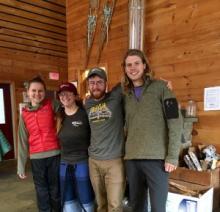
My first overnight at the Maine Huts was marked by moments like these. The serene and rejuvenating natural beauty of the western Maine winter and the rustic feel yet modern facilities of the hut made for an authentic overnight experience. Caleb and Rheanna, the warm and welcoming hut staff, prepared a delicious meal that all ten of us – staff and guests – ate family style around a long wooden table. Lively conversation filled mealtimes, during which I learned about the other guests staying at the hut, all of whom were first time visitors to the Maine Huts & Trails system. After dinner, Caleb and Rheanna gave a comprehensive tour of the hut during which they described all the eco-friendly technologies and practices used there. These included local and sustainable food sourcing, utilization of local businesses and resources during the building process, energy systems powered primarily by solar including a brand-new set of batteries, and a recently repaired hydro-electric station soon to be running.
In the morning, the hut staff cooked up a delicious breakfast of apple-chocolate chip pancakes and an egg and veggie scramble. We then packed up a trail lunch provided by the staff and trekked back along the main ski trail. The silhouette of Sugarloaf and the Bigelows hung majestically behind the leafless trees, adding humbling dimension to the already-beautiful landscape.
After this taste of the MH&T experience I’m excited to get back out to the huts. Next week, I’ll be staying at Stratton Brook Hut and Flagstaff Hut and at each visit, I’ll be honing in on my focus area for the main project of the internship this January. Many thanks so far to the staff at Poplar Hut, the team in the office at MH&T, and my faculty advisors at Colby.
Stratton Brook Hut
Sparkling solar panels caught the last of the day’s light as Stratton Brook Hut lay illuminated by the golden, late-afternoon sun. Snow from three days prior still blanketed the roof of the impressively insulated building, a visible demonstration of its efficient design.
After the three-mile ski in, Benji and Hannah, the hut staff on duty, cheerfully greeted me while bustling around the kitchen preparing dinner. 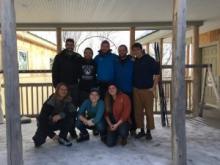 A warm wood stove drew me over to the cozy lounge area where I chatted with other guests, recounting our days in the woods. Following a lively and tasty dinner, Hannah gave an educational presentation on snow science and the history of snow travel for the guests at the hut. She described how temperature and humidity dictate a snowflake’s shape upon its formation, and detailed how different modes of snow transportation evolved to match snow conditions in different areas. The guests, being a diverse group of snow travelers with snowshoers, fat-bikers, and cross-country skiers, engaged enthusiastically in the presentation.
A warm wood stove drew me over to the cozy lounge area where I chatted with other guests, recounting our days in the woods. Following a lively and tasty dinner, Hannah gave an educational presentation on snow science and the history of snow travel for the guests at the hut. She described how temperature and humidity dictate a snowflake’s shape upon its formation, and detailed how different modes of snow transportation evolved to match snow conditions in different areas. The guests, being a diverse group of snow travelers with snowshoers, fat-bikers, and cross-country skiers, engaged enthusiastically in the presentation.
This unique informative experience was part of the new partnership between Chewonki and Maine Huts & Trails, which provides year-round employment to four Chewonki workers and aids MH&T in their educational mission. Mike Spurrier, the Hut Operations Manager, was staying up there with Keith Crowley and Johnson Whippie, Chewonki workers overseeing the new partnership with MH&T. This assorted crowd of outdoors workers at the hut gave me multiple valuable perspectives on potential focus areas and presentation methods for my project this January.
Right now, I’ve narrowed down the focus area to the local/sustainable food sourcing methods of MH&T or their sustainable energy systems. Today, abundant sunshine and light winds usher me off to Flagstaff Hut. I’m looking forward to seeing another hut and gathering further information from staff and guests.
Flagstaff Hut
Interested in an easily accessible off-the-grid hut experience in a beautiful and historically fascinating location? Flagstaff Hut is the perfect place to go. A gentle two-mile trail winds from the trailhead along the eastern shore of Flagstaff Lake to the hut, nestled overlooking the pristine water. Flagstaff Lake is Maine’s largest manmade lake, enlarged by the damning of the Dead River in 1950 for the purpose of regulating water flow for hydroelectric power. At the hut, stunning evenings gift the visitors as the sun sets over the water and behind the Bigelow Range. During summer, the area can be readily explored using canoes and kayaks available at the hut, but this time of year cross country skis and snowshoes provide the best form of adventure on the frozen lake.
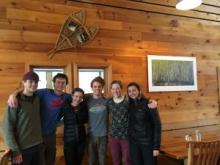
Like all of the other Maine Huts & Trails employees, the hut crew at Flagstaff provided enthusiastic company and welcoming service during my overnight. They served a hearty meal of homemade pizza crisped to perfection, a refreshing winter kale salad, and moist chocolate cupcakes. Over the meal, we chatted about the food sourcing at the huts and all agreed about its importance as an educational subject. The hut crew was enthusiastic about guest interest in the topic and encouraged the idea as the focus area for my internship. Here’s a little more info:
MH&T’s local and sustainable food sourcing helps build a sustainable community in Maine and enhances the dining experience at the huts. Buying food from local, typically smaller, farm operations means greatly reducing the carbon footprint associated with distribution of food since it travels less distance from farm to table. Sourcing from these sorts of farms also supports local business and stimulates the economy in the area. Additionally, well-run organic farming operations have huge environmental benefits including sustainable soil management, lack of pesticide and fertilizer use, and erosion control, compared to traditional industrial style farming. Eating locally grown, organic food also tastes so much better! From sweet winter carrots to tender grass-fed beef, MH&T provides an amazing eating experience for their guests by sourcing as much local and organic food as possible.
Grand Falls Hut
An eight-mile ski in followed the meandering Dead River north, deep into the Maine woods. With each passing river bend, civilization drifted farther behind and a peaceful mind settled more deeply upon me. The trail wound through spacious groves of leafless Poplar trees silhouetted by the piercing blue afternoon sky, overlooking shimmering crystal cold water. Occasionally, thick swaths of pine engulfed the trail allowing needles of sun to pierce through the canopy lighting the woody tunnels. Just two miles from the hut, Grand Falls cascaded 40 feet into a pool below, billowing mist above the sun-kissed treetops into the evening sky. The stunning hydraulic display perforated the otherwise serene landscape.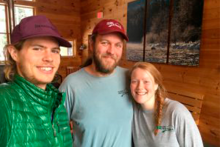
Grand Falls Hut felt like a shrine erected to honor the impressive and remote natural landscape around. Its grand southern wall filled with windows capitalized on heat from solar gain and views of the pine-covered hills across the river valley. After the long ski in, I graciously devoured the meal that Adam and Erin, the hut crew working at Grand Falls, served.
Longtime workers at MH&T, Adam and Erin had the operation at the hut wired and were passionate about continuing to provide and improve the educational and rejuvenating experience for guests. Adam gave me an impressively comprehensive sustainability tour of the hut, and Erin detailed her work on various Maine farms. In particularly, she described a CSA farm that MH&T recently partnered with to provide winter root vegetables at the huts. The mutually beneficial relationship gave the farmer additional income during what had been a below average year for CSA members, and stocked the huts with locally grown, in-season food. Both Adam and Erin believed that local food sourcing was one of the most important and impactful practices of MH&T and advocated for its further development. This could mean increasing the amount of food purchased from local sources as well as increasing guest/public awareness and education of these practices.




